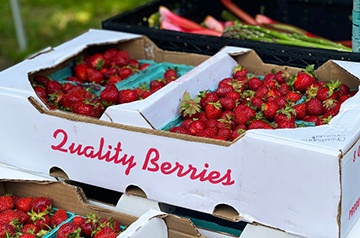
For more information on additional funding, please see New Round of Funding from the USDA Coronavirus Food Assistance Program.
The US Department of Agriculture’s (USDA’s) Coronavirus Food Assistance Program (CFAP) is designed to provide nearly immediate financial assistance to producers of agricultural commodities.
In particular, it seeks to provide relief for those who suffered at least a 5% price decline due to COVID-19 between mid-January 2020, and mid-April 2020, and face additional significant marketing costs as a result of lower demand, surplus production, disruptions to the supply chain, and marketing of commodities. CFAP is intended to support US farmers and ranchers through the pandemic so they can continue to plant, raise, and harvest affordable crops vital to people and the economy.
The Coronavirus Aid, Relief, and Economic Stability (CARES) Act provided the funding for this program via the USDA and the Commodity Credit Corporation. The USDA allocated $9.5 billion, and the Commodity Credit Corporation contributed an additional $6.5 billion of CARES Act funding, which will be used to compensate farmers who qualify for the program.
Learn more about the program’s eligibility, requirements, and application process.
Eligibility
To be eligible for payments, a person or legal entity must have an average adjusted gross income (AGI) of less than $900,000 for tax years 2016, 2017, and 2018. However, if 75% of their AGI comes from farming, ranching, or forestry, the AGI limit of $900,000 doesn’t apply.
Processing, packing, storing, and transportation of farm, ranch, and forestry commodities is included in the definition of farming, ranching, and forestry operations. Interest Charge Domestic International Sales Corporation (IC-DISC) dividends derived from farm, ranch, or forestry activities are also included. To ensure the availability of funding throughout the application period, producers will receive 80% of the total payment, up to the payment limit, upon approval of the application. The remaining portion will be paid at a later date as funds remain available.
Payments will be determined by the agricultural commodity. Visit the USDA website for a full list of eligible agricultural commodities covered under the CFAP program and a calculator to assist estimate payment amounts, but below are the basics of the program.
- Eligible non-specialty crop payments are based on the inventory subject to price risk that is harvested and held as of January 15, 2020, not to exceed 50% of 2019 total production multiplied by the payment rates.
- Eligible specialty crop payments include the sum of three different loss categories. More details are provided below.
- Cattle payments are based on cattle sold between January 15, 2020, and April 15, 2020, multiplied by the payment rates by cattle type plus a producer’s cattle inventory subject to price risk on a date of their choosing between April 16, 2020, to May 14, 2020, multiplied by the payment rate.
- Dairy payments equal the first-quarter production of the calendar year 2020 multiplied by the payment rate. Dairy production for the second quarter is calculated from the first quarter production; second quarter calculated production is then multiplied by the payment rate.
- Table grapes and vineyards aren’t eligible to participate in CFAP at this time. However, additional commodities are being reviewed and potentially added to the program.
Eligible Specialty Crop Payments
As mentioned above, these payments are the sum of three loss categories:
- Specialty crops that were sold between January 15, 2020, and April 15, 2020, the quantity sold is multiplied by the payment rate.
- Specialty crops harvested and shipped, but subsequently spoiled or unpaid due to loss of marketing channels between January 15, 2020, and April 15, 2020, the harvested and shipped quantity that spoiled or were unpaid is multiplied by a different payment rate.
- Unpriced specialty crops that didn’t leave the farm—or mature crops that remained unharvested—between January 15, 2020, and April 15, 2020, due to loss of marketing channel, the sum of the quantity of crops that didn’t leave the farm (FSA) and the quantity of mature crops that remained unharvested is multiplied by a different payment rate.
There’s some confusion regarding the different loss categories and how to handle pooling, deferred payments, unsold inventory, and more. Various trade associations are working with the USDA for further guidance.
Limitations
CFAP payments are subject to a per-person and legal entity payment limitation of $250,000. This limitation applies to the total amount of CFAP payments made with respect to all eligible commodities.
Unlike other FSA programs, special payment limitation rules will be applied to participants that are corporations, limited liability companies, and limited partnerships. These entities may receive up to $750,000 based upon the number of shareholders—not to exceed three shareholders—who contribute at least 400 hours of active person management or personal active labor.
How to Apply
CFAP applications opened on May 26, 2020. The USDA is accepting applications through August 28, 2020. Producers should apply through the Farm Service Agency at their local USDA Service Center.
While USDA Service Centers are open for business by phone appointment only, FSA is working with agricultural producers by phone and using email and online tools to process applications. Please call your FSA county office to schedule an appointment. You can find contact information for your local USDA Service Center by going to the bottom of the USDA website.
The USDA is currently evaluating commodities that aren’t eligible to receive payments through the Notice of Funding Availability process. If you have a commodity that you grow that isn’t on the list of eligible commodities, check back with your local FSA office at a later date to see if your commodity was added.
We’re Here to Help
If you have questions about your eligibility, how to apply, or general questions about the program, please reach out to your Moss Adams professional.